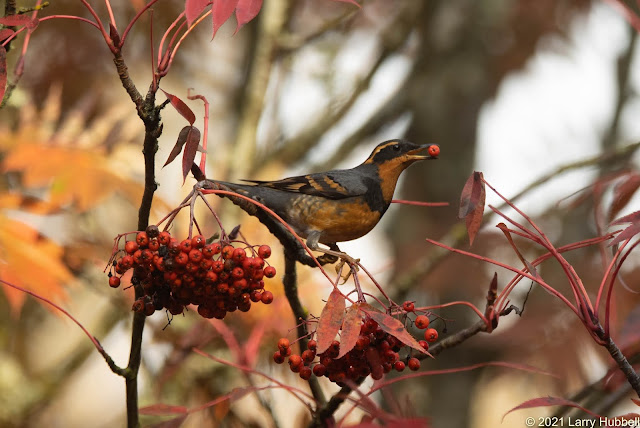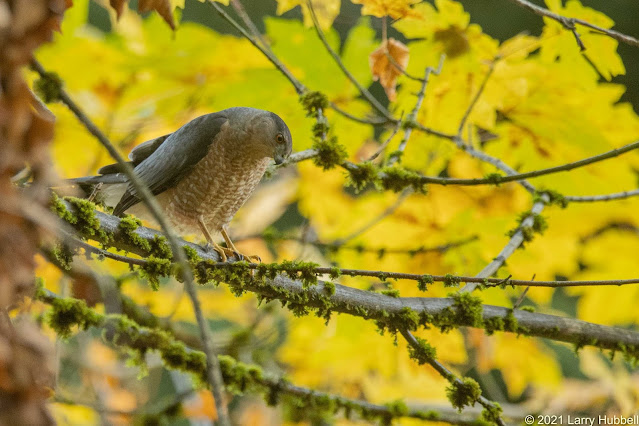In the Fall, when the fruit of the Sorbus trees is ripe, the American Robins invade the trees and consume vast quantities. They seem to avoid the darker, overly ripe options. Taking flight while powered by fermented fruit would probably lead to broken wings or worse.
I suspect the consistent faint-white edging on the reddish-orange breast of this bird indicates it is a first-year bird. Earlier in the year, its breast would have been covered with spots. As Winter approaches it must look and behave like an adult to survive. The parental delivery of food has most certainly stopped.
The supply of Sorbus fruit, from multiple species of trees originating all over the world, made the Arboretum a magnet for American Robins this week.
Often, Robins will swallow multiple pieces of fruit before quickly retiring to a nearby conifer where they can sit, safely hidden, while they process their plunder. Sometimes they take one more for the road.
With a flock of birds each operating on their own digestive schedule, they could be seen coming and going from multiple directions all at the same time - a furious Fall frenzy of feeding.
This is further enhanced by the occasional Robin who is apparently offended by a family member landing too close to "their" fruit. The two birds leave the tree with the offended individual in hot pursuit. The effort seems totally futile as neither bird is feeding during the chase, although it usually ends quickly. These skirmishes seem to be more about some misconstrued concept of honor than fruit.
The fruit is so abundant that the Robins can afford to be picky. This particular piece of fruit was evidently not quite ripe enough. The Robin appeared to test the firmness once or twice before giving it a final squeeze. Pinching with just the tips of its bill caused the fruit to 'leap' away from the bird. The avian version of spitting it out.
The rejected fruit can be seen falling towards the ground. It is just above the branch and directly in front of the vertical bud. Comparing this photo to the previous one makes it a bit more obvious.
Here is a different example of the same behavior. The photo captures the moment just before gravity takes over.
American Robins are members of the Thrush family. The pattern of color on Robins is unique among Thrush. However their shape seems consistent among all four species that can be found in our area. The size of the Robins, and to some extent their colors, are most similar to that of the Varied Thrush.
Varied Thrush also feed in the Sorbus. However they are shyer and less plentiful than their cousins, the Robins. Binoculars would be very helpful when looking to differentiate these two different species of Thrush.
This time of year you are more likely to hear the "chuck, chuck, chuck" of a Varied Thrush's call rather than their eerie early-morning, Spring song, which sounds kind of like a referee's whistle.
The black on this bird's face, and the black stripe across the chest, indicate it is a male.
A black head on an American Robin indicates it is a male.
While a grey-brown head indicates a female. However lighting makes a difference. Given the position on the branch, I suspect this may be the same bird in both this and the previous photo.
In any case, the very first photo in this post depicts a male American Robin, since the black on the head is clearly different from the color on the bird's back.
On Wednesday, as I walked through the Sorbus, everything was curiously quiet. I wondered where the Robins and Varied Thrush had gone. There was still plenty of fruit hanging on the trees. As I walked further south, I started occasionally hearing and seeing Robins in the shadows among more tightly packed conifers and Big-leaf Maples.
Not long after, I heard the "kek, kek, kek" of a Cooper's Hawk. Even with the clear sound of the call, it took a while to zero in and find the source.
A Cooper's Hawk is a 'crow-sized' predator that would love to have a Thrush for lunch. It was very alert and clearly watching for prey.
I followed it from one tree to the next as it hunted its way back toward the Sorbus trees.
When it spotted an appropriately sized bird in flight, most likely an American Robin, the Hawk gave chase and disappeared to the north. Maybe those futile flights, inspired by the Sorbus berries, actually serve a useful purpose for the Robins. Possibly, they keep them in shape so they have a shot at escaping from predators.
With the Cooper's Hawk gone and the Robins well hidden I walked back to the Sorbus trees, which were still virtually empty of birds. The concept 'Safety First' may not have originated with humans.
Then, suddenly to my astonishment, a flock of Robins descended out of the conifers and began consuming the Sorbus berries again. With no Hawk to fear, and with the heavy rains heading our way, there was no time to lose. The Robins returned to their frenzied feast.
The last and most elusive Thrush that I have found eating Sorbus fruit is the Hermit Thrush. It is more similar in size to a Song Sparrow than a Robin, and at the slightest noise it will disappear. Given its retiring nature, the name seems like a perfect fit.
Because of its diminutive size, it apparently cannot easily consume most of the Sorbus fruit found in the Arboretum. So, they normally only feed on the few Sorbus trees which have exceptionally small fruit and are close to dense undergrowth where they can quickly hide.
Technically, from the front, I cannot tell a Hermit Thrush from a .Swainson's Thrush. (If you follow the highlighted links to All About Birds you can see that the Hermit Thrush has a slightly reddish-brown tail and the Swainson's Thrush has a basic brown tail - the exact same color as its back.) On every occasion, when I have been able to see the tail clearly, I have only found Hermit Thrush in the Arboretum.
Although the angle and the light often leave me with an inconclusive identification.
I am certainly looking forward to someday securing photographic proof of a Swainson's Thrush in the Arboretum.
Have a great day on Union Bay...where nature lives in the city and Black Birder's are welcome!
Larry
Going Native:
Each of us, who breathe the air and drink the local water, needs to watch and protect our local environment. Native plants and trees encourage the largest diversity of lifeforms because of their long intertwined history with our local environment and native creatures. I have been told that even the microbes in the soil are native to each local landscape. I hope we can inspire ourselves, our neighbors, and local businesses to respect native flora and to support native wildlife at every opportunity. I have learned that our most logical approach to native trees and plants (in order of priority) should be to:
1) Learn and leave established native flora undisturbed.2) Remove invasive species and then wait to see if native plants begin to grow without assistance. (If native plants start on their own, then these plants or trees are likely the most appropriate flora for the habitat.)3) Scatter seeds from nearby native plants in a similar habitat.4) If you feel you must add a new plant then select a native plant while considering how the plant fits with the specific habitat and understanding the plant's logical place in the normal succession of native plants.
Click Here to access a King County publication that explains the best placement for a wide variety of native plants. It looks extremely helpful.
Also, my friend Tom Brown pointed out that the application named 'Wildflower Search' is very helpful. Click on the highlighted link to see for yourself.
Also, Jane Lundin has created a small package, with a lot of critical information that looks quite handy, and light, for backpacking in the mountains in Springtime. It is titled, Mountain Wildflowers of Washington.)
Another idea that integrates perfectly with living in harmony with nature is the concept of Forest Gardening. Native Americans collected and nurtured dense multi-layered gardens of native herbs, plants, shrubs, and trees that produced food and herbal medicines. Even after 150 years of no maintenance, the gardens are essentially intact and the diversity of life remains significantly higher than in the surrounding forests. Click Here to learn more.
**************
In the area below it is my intention to display at least one photo each week to help challenge us to know the difference between native and non-native lifeforms.
This week we have five photos of ferns. They are all native to our area. Your challenge this week is to match the names with the correct photos. The ferns are:
A) Giant Chain FernB) Licorice FernC) Sword FernD) Maidenhair FernE) Lady Fern
Scroll down for the answer.
****************
1 - D Western Maidenhair Fern
2 - A Giant Chain Fern
3 - E Lady Fern
4 - B Licorice Fern
5 - C Western Sword Fern
There is additional information attached to each highlighted link. I hope you enjoyed the Quiz!
*****************
The Email Challenge:
In response, I have set up my own email list. With each post, I will manually send out an announcement. If you would like to be added to my personal email list please send me an email requesting to be added. Something like:
Larry, I want to see more of nature. Please add me to your personal email list.
Thank you for your patience and interest!
My email address is:
LDHubbell@comcast.net
*******************
A Final Photo:
Yesterday, after the rainfall raised the water level in Arboretum Creek three more inches, this (presumed) Hermit Thrush was sitting happily between two Sorbus trees and apparently enjoying the rain break.

























Love it. You bring nature to my desktop. Thanks.
ReplyDeleteJoan
Love it. You bring nature to my desktop. Thanks.
ReplyDeleteJoan
I remember clearly that we met the first time around the Sorbus trees and talked about beautiful Varied Thrushes. Oh, I miss them so much in the Fall, from Chicago!
ReplyDelete